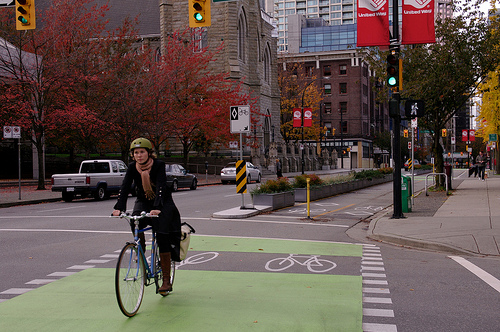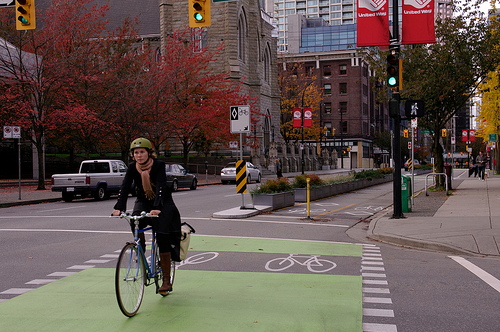 A physically separated bike lane in Vancouver, B.C. Looks nice, right?Photo: Paul KruegerIt’s long been the most controversial issue in bicycling:
A physically separated bike lane in Vancouver, B.C. Looks nice, right?Photo: Paul KruegerIt’s long been the most controversial issue in bicycling:
Should people on bikes ride in traffic with cars, using the same infrastructure and following the same procedures (a style of riding known as “Vehicular Cycling”)?
Should we ride on the sidewalks and off-road paths, with pedestrians?
Or should we have our own place to ride that’s designed specifically for bicycling?
Like Goldilocks, we’ve tried all these options. Riding with faster, heavier cars is hard on us. Riding with slower, roaming pedestrians is hard on them. Only when we have our own place in traffic are things anywhere near just right.
Or so says a study released last week in Montreal, which shows that not only does dedicated bicycle infrastructure work in North America, it borders on negligence for cities not to build such infrastructure. (You can download the entire study here [PDF].)
We’re not talking about the old, familiar bike lane, marked by a line of white paint — which so often functions more as a symbol and reminder of our right to be in the road than as actual bicycle infrastructure. Car doors, intersections, potholes, and misinterpretations by law enforcement are among the many pitfalls of the old-school bike lane. But on any road where car traffic is traveling significantly faster than a person can pedal, a bike lane, flawed compromise that it is, is better than nothing at all.
Cities across North America have in the last two years been discovering a better way to build a bike lane — separating it entirely from motor vehicle and pedestrian traffic alike.
It’s called the cycle track. Though we recently discovered it, we didn’t invent it: It’s been the backbone of the world’s most attractive, comfortable, safe bicycling environments for decades in European cities like Utrecht and Groningen (see the system in action below).
Cycle tracks, also called segregated bike lanes or separated bike paths, are basically bike lanes that use the same right of way as a major street but are set off from car traffic by a barrier more substantial than a single painted white line. They may be separated by bollards, a concrete barrier, or a curb. On many streets, parked cars provide the barrier. Some cycle tracks are one-way and others carry two directions of bike traffic.
Unlike their more dangerous cousins, the off-road bike paths, cycle tracks are for bikes only and are not intended to be shared with people walking or running and more than with cars.
Montreal, the focus of the recent study, has an unusually large number of cycle tracks for a North American city. Still, unlike their European cousins, these are mainly two-directional and have what the study calls a “less than ideal design,” particularly at intersections.
Even so, the researchers found, these lanes enjoy 2.5 times more bicycle traffic than alternate bicycle routes without cycle tracks. On Montreal’s cycle tracks, the risk of injury is 28 percent lower — or to be exact, 10.5 crashes, but only 8.5 injuries — per million kilometers bicycled.
Despite strong evidence from now two continents, the Montreal researchers point out, United States federal guidelines actively discourage cities from building cycle tracks.
Everywhere cycle tracks are proposed and built there is some amount of local pushback. We’re seeing an extreme degree of this in New York City, where a powerful group that includes the city’s former transportation commissioner (who just happens to be married to Sen. Chuck Schumer [D-N.Y.]) have filed a lawsuit to remove a successful two-way cycle track recently built along Brooklyn’s Prospect Park. The media has embraced the campaign, with a local politician contributing the most venomous and spirited rhetoric.
There is also a vociferous cadre of bicyclists who organize against bicycle infrastructure of all kinds, with the slogan: “bicyclists fare best when they act, and are treated in return, as drivers of vehicles.” One such Vehicular Cycling organization in Ottawa, Ontario is rallying against a high-profile cycle track planned in Canada’s capital city.
But as the research keeps rolling in, I suspect we’ll continue to find that real bicycle infrastructure is going to be an amazing boon to bicycle transportation. For instance, we already knew that the air quality is better, whether you’re riding on a cycle track or walking on the sidewalk next to one.
We know that, despite shopkeepers’ fears, increased bicycling is good for business.
We know that people will ride in greater numbers on dedicated, separated bicycle infrastructure, and that with numbers comes safety.
As long as we continue to allow our streets to be dominated by cars, we need to go the extra mile — or thousand miles — to ensure that everyone who isn’t in a motor vehicle at any given time is still able to move freely around the city. Separated infrastructure, like sidewalks and cycle tracks, are necessary if a car-oriented city is to be navigable by unarmored humans. Some day, I hope we don’t need them. Until then, I hope we build them as well as possible.




